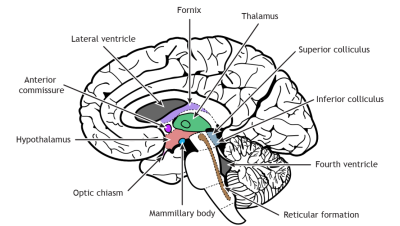
The superior colliculus (light gray) is located at the top of the midbrain in mammals. Image credit: Casey Henley
The superior colliculus is a midbrain region that is traditionally thought to help animals orient themselves toward important locations in space, like directing their eyes and head toward a bright flash of light. New research from the University of Chicago shows that this part of the brain also plays a role in complex cognitive tasks like visual categorization and decision making.
In the new study, published in Nature Neuroscience, scientists measured the information contained in patterns of brain cell activity across multiple brain regions involved in visual category decisions. The researchers monitored activity in the superior colliculus (SC) and part of the posterior parietal cortex (PPC), a region of the cerebral cortex that is important for visual categorical decisions. To their surprise, they saw that activity in the SC was even more involved than the PPC in guiding the subjects’ category decisions, suggesting that it helps coordinate higher-order cognitive processes traditionally thought to take place in the neocortex.
For this study, the researchers trained monkeys to perform a visual decision-making task in which they viewed images on a computer screen. The animals received fruit juice rewards for pushing a button at the right times to assign images to the correct categories.
The researchers saw lots of activity in the SC that encoded the categories of the images the animals were looking at, and this activity took place more strongly than in the PPC. They also performed an experiment in which they injected a drug to temporarily numb the SC during the same task. While this didn’t impair most of the subjects’ motor and visual functions, it dramatically affected their ability to correctly categorize the images until the effects of the drug wore off, suggesting the SC is important for the task of categorizing visual information.